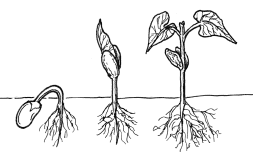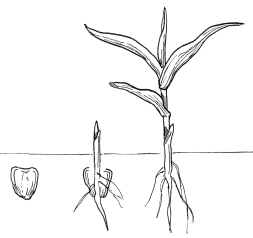Aside from the conifers, most of our common garden plants are classified as angiosperms, or flowering plants. Evolutionarily,
this enormous group of plants represents the youngest and most highly developed group of
plants. The term angiosperm is derived from the Greek words for "vessel" and
"seed," alluding to the fact that their seeds are borne within an ovary, a
protective structure within the flower.Angiosperms
represent an advancement over gymnosperms not only in that their seeds are more protected,
but also in their modes of pollination. Gymnosperms rely solely on wind to transfer
pollen, whereas many of the angiosperms enlist the help of insects and other animals for
transferring pollen and increasing the likelihood of fertilization.
Monocots and dicots. The angiosperms are divided
into two classes: the monocots and the dicots. This distinction is based on the number of
cotyledons, the food storage structures in their seeds. Monocots have one cotyledon,
dicots have two.
A good example of a dicot is a bean plant. A bean seed can
be split in half lengthwise into the two cotyledons. Inside is the embryonic stem, root,
and tiny leaves. When the seed germinates, the two cotyledons emerge from the soil to form
the seed leaves. The seed leaves nourish the plant until it can form its true leaves. (Not
all dicots’ seed leaves emerge during germination; for example, peas are dicots, but
the pea cotyledons remain underground.)

Corn is an example of a monocot. Corn seed has one
cotyledon and can’t readily be split.

Familiar monocots include grasses, corn, irises, palms,
and lilies. Monocots share other distinctive features: the veins in the leaves are usually
parallel, flower parts (for example petals) are often in threes or multiples of three,
and, lacking a vascular cambium, they don’t form wood in their branches and trunks.
Dicots, on the other hand, are characterized by branched
or net-like veins in the leaves; also flower parts are commonly found in fours or fives,
or multiples thereof. Many dicots do have a vascular cambium; these plants are able to
produce secondary xylem, or wood. All the woody trees and shrubs in your garden are
dicots, as are many herbaceous plants such as tomatoes, squash, and zinnias.
Now that we’ve talked about these different types of
plants, let’s go out in the garden and have a look.
